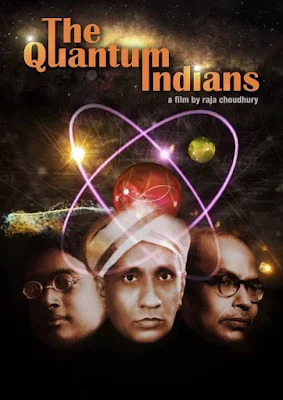 Ramanujam (2014)
Ramanujam (2014)Some 2 years ago, my son asked me about the Indian subcontinent's contribution to the sciences in modern times. He told me about accolades conferred to Indians, but scientific discoveries were far too few to enumerate, he said. Besides telling the usual adage that ‘everything comes from India’, pizza (crusted masala thosai) to noodles/spaghetti (idiyapam) to philosophy to NASA scientists and silicon valley geeks, he was surprised to hear about India’s Nobel prize winner and the Quantum Indians of the early 20th century. These three forgotten Indian scientists of Satyendra Nath Bose, CV Raman and Meghnad Saha revolutionised Physics and Indian Science in the early part of the 20th century by giving the world Bosons, the Raman Effect, the Saha Equation and India's first and only Nobel for Science.
Unlike these highly educated scholars, in Madras, there lived a timid Brahmin boy who thought of nothing else by Mathematics. He slept, drank, ate and even dreamt Mathematics. He loved it so much that he never studied other subjects and to be contended with life without obtaining a degree.
Growing under the shadow of his dominant maternal shield, Ramanujam, grew up as a stickler for rules and Brahminic traditions. Probably these age-old rituals may have been the very reason why he developed such an astute arithmetic aptitude. In school, when told by the teacher that '0' had no value, he argued that by simply placing a zero behind a number, its value increases 10 folds. Hence, '0' cannot be valueless. In another scenario at a temple, he commented that the offerings that the priests were to the well-wishers would be enough after assessing the crowd number and the availability of food. He was not-so-politely told to mind his own business and not to tell the veteran priests to do their job. Sure enough, his calculation came out true much to the amazement of everyone.
As an adult, Ramanujam realised that India does not what outstanding people. What they want are mediocre simpletons who do not think out the box. The parents thought that his fate would change with a marriage but life continued its dull path.
 |
| Ramanujan (centre) with other scientists at Trinity College |
I was particularly impressed with the ritualistic practices that were shown in the film. The devoutly orthodox Brahmin that he is proved to be a scourge throughout his life. First, there was the dilemma of leaving the comfort of the shores of India to go to England. The classical belief is that one who lose his caste and be treated as an outcast by his people. This eventually proved true. After his untimely demise in his early 30s due to tuberculosis, none of his clansmen wanted to attend his funeral. They looked at his death as a sign of wrath of the Gods for crossing the black seas! His particular eating habits, strict vegetarianism, proved self-depreciating. He had to be treated for nutritional deficiencies.
This independent production stars Abinhay Vaddi (the grandson of Gemini Ganesan and Savithri), Suhasini Maniratnam and many famous Tamil movie actors (Sarath Babu, Delhi Ganesh and Radha Ravi among others) appear in cameo roles.
The number 1729 is known as the Hardy–Ramanujan number after a famous anecdote of the British mathematician G. H. Hardy regarding a visit to the hospital to see Ramanujan. In Hardy's words:
I remember once going to see him when he was ill at Putney. I had ridden in taxi cab number 1729 and remarked that the number seemed to me rather a dull one, and that I hoped it was not an unfavorable omen. 'No', he replied, 'it is a very interesting number; it is the smallest number expressible as the sum of two cubes in two different ways. Wikipedia
An equation for me has no meaning unless it represents a thought of God. Ramanujam Srinivasa
 |
| Bose, Raman, Saha |



No comments:
Post a Comment